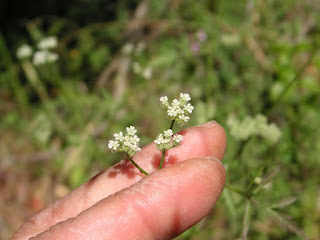May 28, 2012
I've been going out to Fort Ord several times this month of May with various groups and guides. I hope to post more pictures from other outings, so keep an eye on the newest (backdated) entry section above if you don't subscribe to my blog.
This particular outing on Memorial Day was with Dr. David Styer, the 9+ year volunteer who has kept an impressive plant list and has an intimate knowledge of Fort Ord. He goes out every single day and walks a small section and records every blooming plant he sees. I first remember meeting him and his wife Jane on April 1 of this year when Andy and I happened to be out hiking. Apparently, they were both out on the same Army Lands tour that we took last year, but I don't remember particularly meeting them.
The first and last photos above are different views of Mudhen Lake. I questioned David about the difference between lakes and ponds. We talked about the varying temperature differences bottom to top for what qualifies as a lake or a pond. Considering the border plants, I personally view this water feature as a pond. He says a couple years ago this lake/pond dried up completely like a vernal pool. Go figure. For a prettier picture of Mudhen Lake when it had more water, take a look at the 4th photo from the local BLM office site.
Mudhen Lake is significant for Dr. Styer and by extension Fort Ord National Monument. When I first met David, he told me how he "inherited" the original plant list from Charles "Chuck" Haugen. It was during a volunteer outing pulling invasive weeds when Chuck was stung several times by yellowjackets. He went into anaphylactic shock and died here at Mudhen Lake. David clearly remembers that day, because he was also pulling weeds and knew Chuck well. There is an interpretive sign in memoriam Chuck and his service, which I just posted. I wonder if Chuck was the last to die in service at Fort Ord. It was a good reminder of the more general meaning of Memorial Day.
This particular outing on Memorial Day was with Dr. David Styer, the 9+ year volunteer who has kept an impressive plant list and has an intimate knowledge of Fort Ord. He goes out every single day and walks a small section and records every blooming plant he sees. I first remember meeting him and his wife Jane on April 1 of this year when Andy and I happened to be out hiking. Apparently, they were both out on the same Army Lands tour that we took last year, but I don't remember particularly meeting them.
The first and last photos above are different views of Mudhen Lake. I questioned David about the difference between lakes and ponds. We talked about the varying temperature differences bottom to top for what qualifies as a lake or a pond. Considering the border plants, I personally view this water feature as a pond. He says a couple years ago this lake/pond dried up completely like a vernal pool. Go figure. For a prettier picture of Mudhen Lake when it had more water, take a look at the 4th photo from the local BLM office site.
Mudhen Lake is significant for Dr. Styer and by extension Fort Ord National Monument. When I first met David, he told me how he "inherited" the original plant list from Charles "Chuck" Haugen. It was during a volunteer outing pulling invasive weeds when Chuck was stung several times by yellowjackets. He went into anaphylactic shock and died here at Mudhen Lake. David clearly remembers that day, because he was also pulling weeds and knew Chuck well. There is an interpretive sign in memoriam Chuck and his service, which I just posted. I wonder if Chuck was the last to die in service at Fort Ord. It was a good reminder of the more general meaning of Memorial Day.








